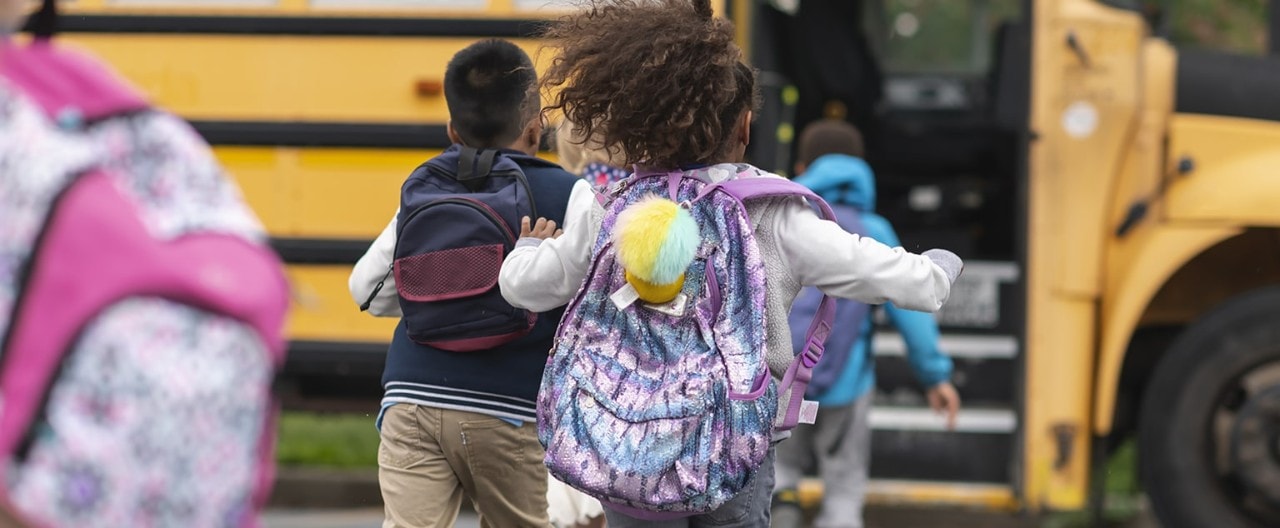- Not insured by the FDIC or any other government agency
- Not bank guaranteed
- Not a deposit or obligation
- May lose value


Preparing to send your kids back to school can feel overwhelming. There are schedules to juggle, routines to re-establish, and of course, back-to-school shopping to do. The list of things you’ll have to buy will vary from grade to grade and from school to school, but on average back-to-school spending can top several hundred dollars in many families. In fact, parents of kids in K-12 schools said they planned to spend nearly $800 on average in 2020, according to the National Retail Federation.1
The price of school supplies, new clothes, electronics, and school fees can add up fast. But with some planning and preparation, back-to-school spending doesn’t have to wreak havoc on your household budget—and it can even serve as an opportunity to teach your children some basic financial skills. Here’s how to create a back-to-school budget to help keep your spending on track as you start the school year.
Involving your children in every aspect of the budgeting process gives them some power in the purchasing decisions and helps them learn how to prioritize their spending. For example, if they really want a set of fancy pens or an expensive notebook, they will need to find less expensive options for some of their other supplies.
The first order of business is to take inventory of what supplies you already have on hand. Consult the school to determine what supplies you’ll need (many districts send out school supply lists in late July or early August) and use that information to make a comprehensive list of what you’ll need to find. Then have your kids round up anything you may have left over from previous years so you can narrow the list to just what you’ll need to buy.
Research provides another opportunity for your kids to pitch into the effort. It’s also a good time to teach them about concepts like price and value since the cheapest option may not always be the best over the course of a school year. And they will quickly learn how to shop around to figure out how much the price of an individual item can vary from one store to another.
Keep in mind that timing can also help you score deals. Many stores offer back-to-school sales in late summer, and since most schools in Ohio, Kentucky, and Indiana start in mid-August, this is a great time to shop for supplies. Ohio also holds an annual “tax-free weekend,” usually at the beginning of August, when many school supplies are exempt from sales tax.
Back-to-school spending doesn’t only mean clothes and notebooks. You’ll also need to consider technology needs (especially if your child is in middle or high school) as well as potential transportation costs. Will your child need access to a graphing calculator, a laptop, or a tablet? If so, find out whether the school will provide it or whether you’ll have to purchase it yourself.
Transportation costs might also be a factor, depending on your kid’s school and how far away you live. For example, Cincinnati public schools offer bus transportation for K-12 students who meet certain criteria, like those who live at least a mile away from the school and within the school district’s legal boundaries. Check with your district to determine what transportation options are available and whether you’ll have to pay for them.
Now that you know what you need and the costs, it’s time to set a budget. Walking your kids through this process allows you to talk about the tradeoffs required to make necessary purchases and the difference between things they want and things they need. Once you’ve gone through the budgeting process, it’s time to shop. Nominate your kid Budgeter in Chief and let them lead the shopping. To make it more fun, you can set rewards. If there is a surplus, money left over from shopping can be put in their piggy bank, or use it for an ice cream treat at the end of the day.
When it comes time to check out, have your kids pay the cashier. This is a powerful step where we part with our money in exchange for the goods we’d like to buy, reinforcing the value of our dollars. If you’re paying with a credit card, it’s a good opportunity to explain how it works and that every month you should pay off the entire balance to avoid paying interest.
Think of back-to-school spending as a periodic expense in your overall household budget. It’s something that happens every year, you can proactively plan for it, and your kids can learn valuable lessons in the process. Have them track your back-to-school spending, so they can use that information to create next year’s budget more independently until eventually, they can do the whole process on their own.
1 National Retail Federation, “Back-to-School.” https://nrf.com/research-insights/holiday-data-and-trends/back-to-school
The information on this page is accurate as of January 2021 and is subject to change. First Financial Bank is not affiliated with any third-parties or third-party websites mentioned above. Any reference to any person, organization, activity, product, and/or service does not constitute or imply an endorsement. By clicking on a third-party link, you acknowledge you are leaving bankatfirst.com. First Financial Bank is not responsible for the content or security of any linked web page. Member FDIC / Equal Housing Lender.
You are about to go to a different website or app. The privacy and security policies of this site may be different than ours. We do not control and are not responsible for the content, products or services.
Online banking services for individuals and small/medium-sized businesses.
If you haven't enrolled yet, please enroll in online banking.
Yellow Cardinal resources
* Are not insured by the FDIC. Not a deposit. May lose value.
f1RSTNAVIGATOR is where our business clients can access tools to help manage day-to-day account activity.